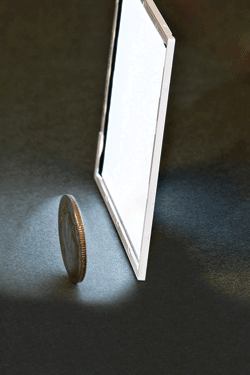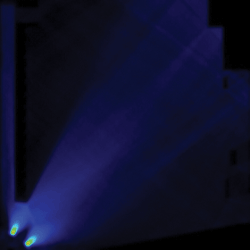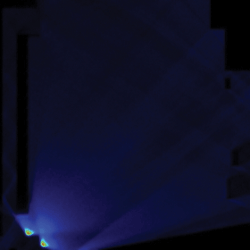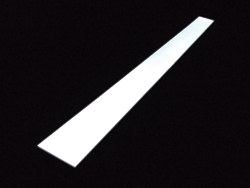Optimizing backlighting with LED edge-lighting
Industry demand for thinner, more-efficient backlights is bringing to the fore edge-lit illumination solutions that use fewer LEDs
BY BRETT SHRIVER
Global Lighting Technologies (GLT)
Brecksville, OH
http://www.glthome.com
Superior light-extraction efficiency, combined with an optimum backlight-unit (BLU) system design, maximizes the advantages provided by the latest advances in LED technology. Those advances have been considerable, with LEDs rapidly become thinner and more efficient.
The result of these advances is smaller, thinner, and more efficient LCDs, keypads, and touchscreens for handheld devices, as well as thinner portable and desktop computer LCDs, with ultrathin keyboard backlighting. The latest designs provide high luminance and uniformity in virtually any color all with fewer LEDs. Thinner, more lightweight BLUs with lower manufacturing costs including backlight assemblies less than 0.6 mm thick utilizing light guides as thin as 0.25 mm are now a reality (see Fig. 1 ). BLUs have reached the thinness of electroluminescent (EL) backlighting, but with all the advantages of today’s advanced LEDs combined with superior light extraction.

Fig. 1. BLUs have achieved amazing thinness while providing lighting uniformity as well as brightness.
LEDs have moved well beyond their established turf in the portable/handheld arena and are the standard in midsize LCDs (3.5 to 7 in. diagonal) used in a variety of consumer, industrial, automotive, and medical displays, as well as in the larger LCDs used in notebook computers, desktop monitors, and flat-panel TVs. Today more than ever, designers and manufacturers of these devices are leveraging the advantages of LED backlighting: wider color gamut, longer life, dc power with no inverter, lower power consumption, greater design flexibility, a smaller form factor, and lower cost. And, of course, LEDs’ mercury-free construction and longevity offer a “green” environmentally friendly backlight.
New solutions beyond display backlighting applications include edge-lit light-guide units for exit signs and all manner of egress lighting as well as edge-lit illumination for downlights such as task lights and troffers. New design approaches such as edge-lighting and light blades are enhancing these benefits.
Edge-lit LED backlighting
Edge lighting employs side-firing high-efficiency LEDs that focus the light into a high-performance, very thin light guide. There are several light-extraction technologies utilized: printed, etched (using chemical, laser, or other means), V-groove, and microlens, each of which can be used to provide the optimum solution for a particular application (see Table 1 ).
| Table 1. Comparison of edge-lighting methodologies | ||
| Technology | Efficiency | 2D pattern possible |
| Printed dots | Low | Yes |
| Etched dots | Good | Yes |
| V-grooves | Very good | No |
| microlens | Very good | Yes |
Since the LEDs are located on the edge of the light guide, this approach offers benefits that include better optical control especially of color and uniformity fewer LEDs, better repeatability at all levels, reduced power consumption, and the thinnest possible LED lighting solution.
Edge-lit backlighting allows for color mixing within the light guide. This not only eliminates the LED-to-LED deviations that can be evident in the direct lighting (light array) approach, but also makes edge-lit light guides very adaptable to today’s multi-function displays, allowing designers to use fewer LEDs and reduce costs.
To maintain optimum efficiency, the light guide thickness should be matched to the output profile of the LED. As LEDs are designed with thinner profiles, the thickness of edge-lit light guides will continue to decrease. However, manufacturing efficient light guides in very thin profiles requires the latest in manufacturing and optical light-extraction technology.
Modeling with lens arrays
A key technique used to enhance uniformity is lens arrays (see Fig. 2 ). Lens arrays are light distribution features that are located on the input edge of the light guide (in front of the LED). These arrays increase the angular output distribution of the light within the light guide to provide for a uniform visual appearance using a reduced number of light sources while minimizing the hot spots that can occur when an LED is too close to the viewing area. Using lens arrays permits a reduction in the number of LEDs required while still achieving a uniform backlight. This enables savings in cost, space, components, and power.

Fig 2. Using a lens array configuration like the one shown permits a reduction in the number of LEDs required while still achieving a uniform backlight.
For the examples shown in Fig. 3 , two side-emitting high-brightness LEDs with optimal light coupling to the edge-lit light guide were chosen. Then, baseline optical modeling was performed on the system to determine the natural spread of light. An array of customized optical lenses was then added to improve the usable distribution of the light from the LEDs and to spread the light more widely than it was in the manufacturer’s original design.


Fig. 3. By using customized optical lenses, the natural spread of light in the original design (top) is enhanced to provide a broader spread of light (bottom).
Backlighting applications
Portable computers have widely adopted edge-illuminated backlighting with white phosphor LEDs. For such applications, a blue LED is imbued with an amber phosphor to convert the visible wavelength to white. The white LEDs still deliver a percentage of the color spectrum comparable to CCFL (approximately 75% compared to 70% to 80% for the CCFL) while providing lower power consumption.
Traditionally, these backlights have been 2 to 3 mm thick; however, with advancements in LED and light guide technology, backlights as thin as 0.4 to 0.6 mm are currently being created to allow for reductions in the total weight and thickness of these devices.
New, thinner LED-based backlights are also being designed into portable device keyboards, providing optimal brightness and uniformity along with the ability to utilize fewer LEDs, thereby reducing the cost and power consumption of the backlight. The backlight design utilizes microlens light extraction technology and optical engineering to increase the efficiency of light transmittal through the keyboard’s key caps, increasing brightness while creating a more uniform illumination.
Beyond displays
The benefits of edge-lighting are by no means confined to backlighting LCDs or keyboards. Edge-lit molded light guides offer an extremely flexible design that allows them to be used with various light extraction technologies and molded to a wide variety of sizes for use in general illumination applications such as egress lighting; downlighting; under-cabinet, splash, and desk task lighting; refrigeration lighting; and cabinet illumination (such as medical cabinets).

Fig. 4. Light blades can be constructed using a 0.2-in.-thick edge-lit light guide (left). The drawing (below) shows the construction of a 3 x 42 x 0.3-in. light blade that uses a light guide edge-lit by 8 LEDs; this design approach can be used in many different sizes and LED configurations for various applications.
The edge-lit panel in Fig. 4 shows a single light blade that is thin and very efficient at providing diffuse lighting with an indirect light source. It can be custom designed for a variety of applications, such as troffer downlights, under-cabinet and desk task lighting, and refrigeration illumination. The blades can be “tiled” to facilitate large-area illumination or manufactured in vary large sizes so as to use a single light guide to illuminate areas over 60 in. diagonally while maintaining a very thin profile.
New advances in light extraction efficiency and manufacturing capabilities, coupled with lens arrays and optical modeling techniques, are using the increased efficiency of today’s LEDs to create edge-lit light guide units from small (0.24-in.-diagonal) to large (60-in.-diagonal) sizes. They are growing steadily thinner and require fewer LEDs to suit a wide range of applications, from display backlighting to general illumination. ■
Advertisement
Learn more about Global Lighting Technologies





